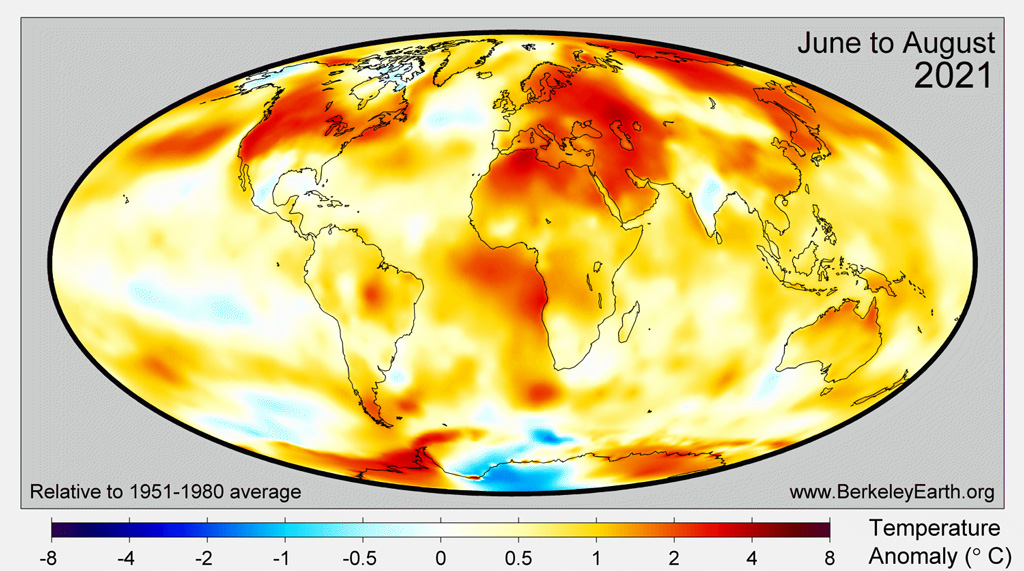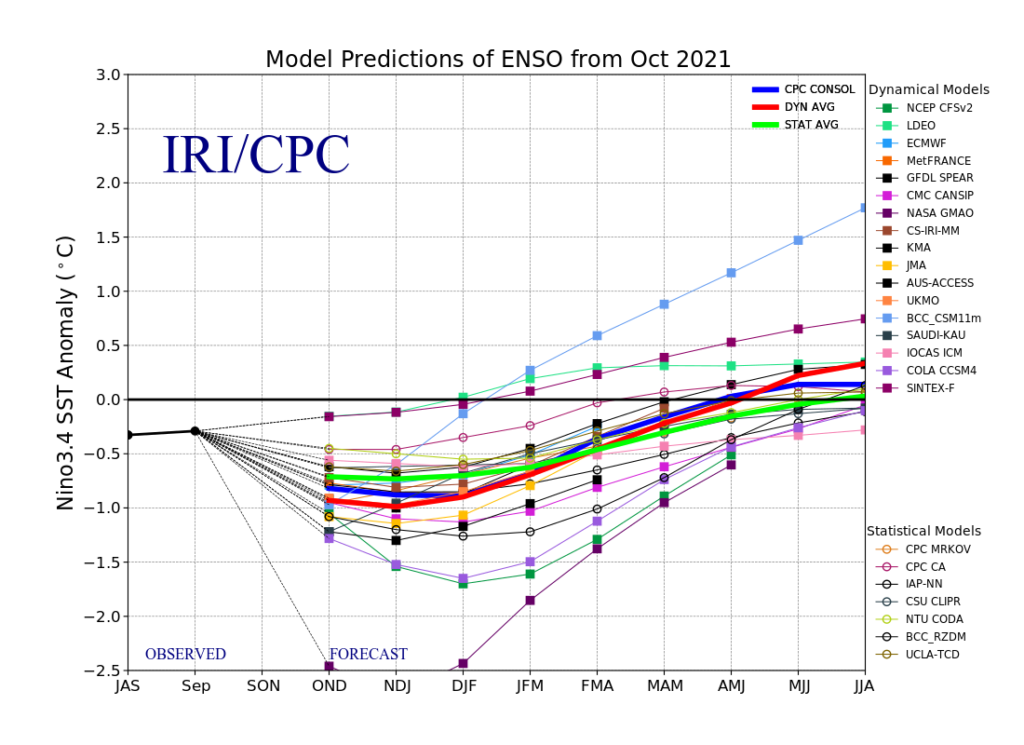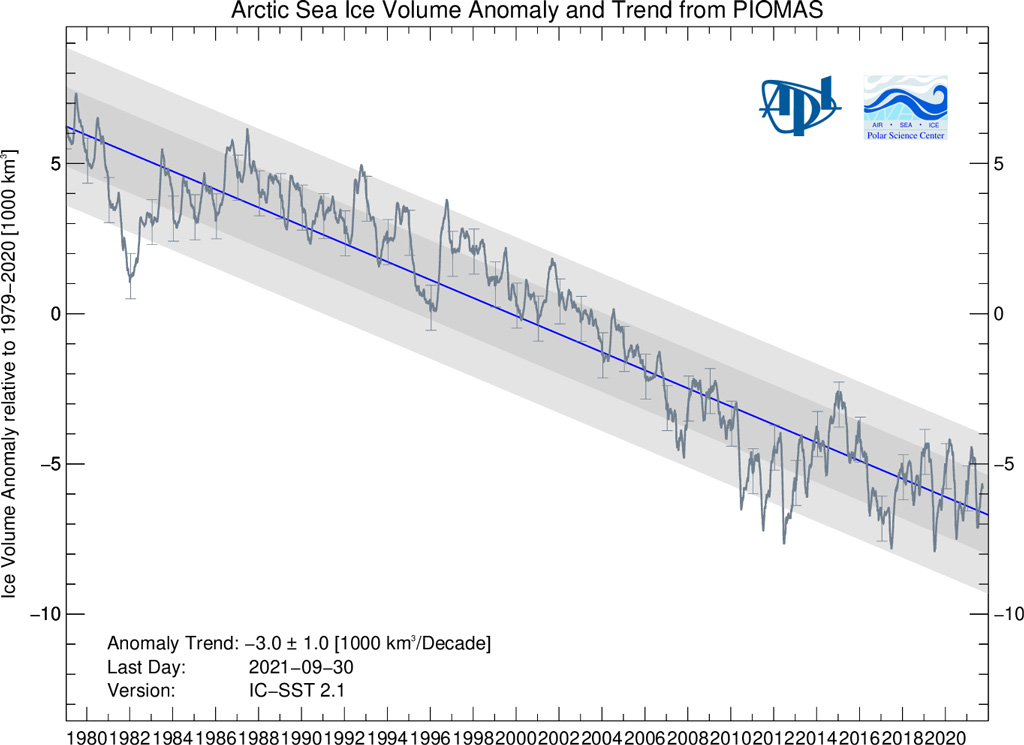The year so far has been one of extremes, featuring record-shattering heatwaves, wildfires and flooding, as well as the warmest-ever meteorological summer – June, July and August – in the global land-surface record.
As a whole, the world is on track to have its fifth to seventh warmest year on record – depending on the dataset examined and how the last three months of the year play out.
The year had a relatively cool start due to remnants of a La Niña event in late 2020 and early 2021. Warm land temperatures over the past few months have been balanced out by cooler ocean temperatures as La Niña conditions have re-emerged.
This year will not set a new global temperature record – but, even in a warming world, most individual years will not. Temperatures will end up around expected levels given the long-term warming trend over the past 50 years and are consistent with projections from climate models.
The first nine months of the year saw record concentrations of major greenhouse gases – CO2, methane and nitrous oxide – in the atmosphere. Arctic sea ice extent was low for much of the year, but recovered in late summer to set a minimum level on the 12th lowest on record.
Warmest summer on record for Earth’s land areas
The summer of 2021 saw extreme heat events, extreme rainfall and flooding, catastrophic wildfires and other extreme events across the world. (These were discussed in-depth in a Carbon Brief guest post published last month.)
With data through to the end of the summer now available, Carbon Brief can now confirm that the meteorological summer of 2021 was the warmest summer on record for the world’s land areas – and the fourth warmest summer on record for the globe as a whole (ocean, land and air).
While global temperatures are a key indicator of climate change, no human experiences the global average. Land regions have, on average, warmed around 50% faster than the world as a whole, with higher latitude land regions warming faster still.
The figure below shows summer – June, July and August – temperatures from the Berkeley Earth dataset between 1850 and 2021. Each red dot represents the average temperature over the three summer months.
Summer (June, July, August) average land surface temperatures from Berkeley Earth. Anomalies plotted with respect to a 1850-1900 baseline. Chart by Carbon Brief using Highcharts.
Summer land temperatures were relatively flat until 1975, with only around 0.2C warming up to that point. Today, summer land temperatures are around 1.5C above pre-industrial levels, with around 1.3C of that warming happening in just the past 45 years.
The exceptional temperatures in 2021’s summer were not uniformly hot. Some regions saw records shattered, while others were closer to average – though a few regions also saw cooler-than-average temperatures.
The map below – from Berkeley Earth – shows summer 2021 temperatures across the globe.

Map of summer (June, July, August) average land surface temperatures provided by Berkeley Earth.
The Northwestern part of North America, Eastern Europe, the Middle East, Northern Africa, and Siberia all experienced exceptionally warm summer temperatures. China, sub-Saharan Africa, South America and Australia were modestly above average, while parts of Central America and India were below average. (The average being defined as the 1951-1980 baseline period used by Berkeley Earth).
Cooler than past few years – but still near-record warm
Carbon Brief has analysed records from six different research groups that report global surface temperature records: NASA; NOAA; Met Office Hadley Centre/UEA; Berkeley Earth; Cowtan and Way; and Copernicus/ECMWF.
The figure below shows the temperature anomalies – changes relative to the 1981-2010 average temperature – for each year since 1970, along with the average over the first nine months of 2021.
(Note: at the time of writing, September data was not yet available for the Hadley/UEA or Berkeley Earth temperature records, so the average over the first eight months is shown for those datasets.)
Annual global mean surface temperatures from NASA GISTEMP, NOAA GlobalTemp, Hadley/UEA HadCRUT5, Berkeley Earth and Copernicus/ECMWF (lines), along with 2021 temperatures to-date (January-September, coloured dots). Anomalies plotted with respect to a 1981-2010 baseline. Chart by Carbon Brief using Highcharts.
Surface temperature records have shown around 1C warming since the year 1970, a warming rate of about 0.19C per decade. The results vary a bit across datasets due to different observations used, adjustments for changes in measurement techniques over time, and methods used to fill in gaps between measurements.
The figure below shows how temperatures so far in 2021 (black line) compare to prior years in the NASA GISTEMP dataset. It shows the temperature of the year-to-date for each month of the year, from January through to the full annual average.
Year-to-date temperatures for each month from 2013 to 2021 from NASA GISTEMP. Anomalies plotted with respect to a 1981-2010 baseline. Chart by Carbon Brief using Highcharts.
So far, 2021 is tied for the 5th warmest to date with 2015 and 2018. It had a cooler start than those years, but warmer temperatures over the past few months have pushed year-to-date values upwards. However, with a growing La Niña event in the tropical Pacific, it remains to be seen whether temperatures will remain relatively warm.
The table below shows how each month in 2021 ranked across all the datasets examined – with “2nd” indicating the second warmest temperature on record for that month occurred in 2021. Note that Hadley and Berkeley extend back to 1850, NASA and NOAA go back to 1880, and Copernicus/ECMWF is only available since 1979.

Rankings of 2021 temperatures by month across different datasets.
February 2021 was unusually cool for the globe as a whole compared to recent years – clocking in at between the 12th and 16th warmest year on record. February was still warm compared to most prior years, however – all but 15 or so years since records began in the mid-1800s had Februaries that were cooler.
Temperatures notably warmed by June 2021, with each month between June and September being between the 2nd and 6th warmest on record, though no months set a new record in 2021 for the global as a whole.
A growing La Niña
El Niño and La Niña events – collectively referred to as the El Niño Southern Oscillation, or ENSO – are the main driver of year-to-year variation on top of the long-term surface warming trend. ENSO events are characterised by fluctuations in temperature between the ocean and atmosphere in the tropical Pacific, which help to make some years warmer and some cooler.
El Niño years tend to be warmer than average, while La Niña years tend to be cooler. There is generally a lag of around three months between when ENSO conditions peak in the tropical Pacific and when their effects on global temperatures are most strongly felt.
Late 2020 and early 2021 saw moderate La Niña conditions that contributed to relatively cool global temperatures in the early part of 2021. ENSO conditions were neutral for much of the spring and summer, before returning to modest La Niña conditions in September and October.
Models now forecast that modest-to-moderate La Niña conditions will persist through the first quarter of 2022. This may result in 2022 being a bit cooler than the past few years as well, though it is too early to know for sure.
The figure below shows a range of ENSO forecast models produced by different scientific groups, with the average for each model type shown by thick red, blue and green lines. Positive values above 0.5C reflect El Niño conditions, negative values below -0.5 reflect La Niña conditions and values between the two represent ENSO neutral conditions.

El Niño Southern Oscillation (ENSO) forecast models for three-month periods in the Niño3.4 region (March, April, May – MAM – and so on). Credit: CPC/IRI ENSO forecast.
On track to be 5-7th warmest year on record
Using the data from the first nine months of the year, plus both past and forecast future ENSO conditions, Carbon Brief has produced a prediction of where 2021 temperatures will most likely land for each different surface temperature record.
The results are shown in the table below, with the probability of the year ending up as the 5th, 6th or 7th warmest on record shown for each dataset. With data for the first three-quarters of the year in, there is virtually no chance that any of the surface temperature records will show 2021 as above the 5th warmest or below the 7th warmest year on record. At the time of publication, September 2021 data was not yet available for the HadCRUT5 or Berkeley Earth datasets.
 Estimated probabilities of 2021’s temperature rank for each dataset, with the most likely outcome in bold. Note that these probabilities do not include measurement uncertainty for each record, just the best estimate. Missing values represent datasets that have yet to report their September temperatures. This article will be updated once they are published.
Estimated probabilities of 2021’s temperature rank for each dataset, with the most likely outcome in bold. Note that these probabilities do not include measurement uncertainty for each record, just the best estimate. Missing values represent datasets that have yet to report their September temperatures. This article will be updated once they are published.
While all three datasets produce similar projections for 2021 annual temperatures, there are slight differences that result in different rankings. This year is most likely to be the 7th warmest on record in the NASA dataset, 6th warmest in NOAA and 5th warmest in Copernicus/ECMWF.
The figure below shows the 2021 to-date temperatures and annual 2021 projected temperatures (with uncertainties) for Copernicus/ECMWF’s ERA5, along with the long-term temperature trend based on data from 1979-2020. While 2021 temperatures will be lower than many of the past few years, they are quite consistent with the longer-term warming trend due to human emissions of CO2 and other greenhouse gasses.
Annual global average surface temperature anomalies from Copernicus/ECMWF plotted with respect to a 1981-2010 baseline. To-date 2021 values include January-September. Estimated 2021 annual value based on relationship between the January-September temperatures and annual temperatures between 1979 and 2020. Chart by Carbon Brief using Highcharts.
With each month of additional data, the uncertainty in the expected 2021 annual temperature shrinks as there are fewer remaining months to change the average. The figure below illustrates this, showing that both the best estimate (red) and uncertainty range (black whiskers) for 2021 annual temperatures have changed over the course of the year as each additional month of data has become available.
Annual global mean surface temperatures from Copernicus/ECMWF for 2016 (blue line), 2020 (black dot) and projections made in each month of the year (red dots and black whiskers). Chart by Carbon Brief.
Current temperature in-line with model projections
Climate models provide physics-based estimates of future warming given different assumptions about future emissions, greenhouse gas concentrations and other climate-influencing factors.
The figure below shows the range of individual models forecasts featured in the Intergovernmental Panel on Climate Change’s (IPCC) fifth assessment report – known collectively as the CMIP5 models – between 1970 and 2030, with grey shading and the average projection across all the models shown in black. Individual observational temperature records are represented by coloured lines.
In these models, estimates of temperatures prior to 2005 are a “hindcast” using known past climate influences, while temperatures projected after 2005 are a “forecast” based on an estimate of how things might change.
Twelve-month average global average surface temperatures from CMIP5 models and observations between 1970 and 2021. Models use RCP4.5 forcings after 2005. They include sea surface temperatures over oceans and surface air temperatures over land to match what is measured by observations. Anomalies plotted with respect to a 1981-2010 baseline. Chart by Carbon Brief using Highcharts.
While global temperatures were running a bit below the pace of warming projected by climate models between 2005 and 2014, the last few years have been pretty close to the model average. This is particularly true for globally complete temperature records, such as HadCRUT5, NASA, Berkeley Earth and the Copernicus/ECMWF reanalysis, which include temperature estimates for the whole Arctic.
Greenhouse gas concentrations reach record highs
Greenhouse gas concentrations reached a new high in 2021, driven by human emissions from fossil fuels, land use and agriculture.
Three greenhouse gases – CO2, methane (CH4) and nitrous oxide (N2O) – are responsible for the bulk of additional heat trapped by human activities. CO2 is by far the largest factor, accounting for roughly 50% of the increase in “radiative forcing” since the year 1750. Methane accounts for 29%, while N2O accounts for around 5%. The remaining 16% comes from other factors including carbon monoxide, black carbon and halocarbons, such as CFCs.
Human emissions of greenhouse gases have increased atmospheric concentrations of CO2, methane and nitrous oxide to their highest levels in at least a few million years – if not longer.
The figure below shows concentrations of these greenhouse gases – in parts per million (ppm) for CO2 and parts per billion (ppb) for methane and nitrous oxide – from the early 1980s through July 2021 (the most recent data currently available).
Global concentrations of CO2, methane (CH4) and nitrous oxide (N2O). Based on data from NOAA’s Earth Systems Research Laboratory. Note that the y-axes do not start at zero. Chart by Carbon Brief using Highcharts.
The atmospheric concentration of CH4 began to increase again in 2006 after a plateau from 1999. It further sped up since 2014, with roughly linear growth of 8ppb each year since. Unlike CO2 and N2O, CH4 has a relatively short atmospheric lifetime and does not accumulate in the atmosphere in the long term. This means that – to a first approximation – the level of CH4 in the atmosphere is directly proportional to the level of emissions over the past decade.
If emissions remain flat, atmospheric CH4 will be flat, while increasing emissions will show up as increased atmospheric CH4. If CO2 and N2O emissions remain flat, on the other hand, atmospheric concentrations would continue to increase.
While there are some complications around changes in the ability of the atmosphere to remove CH4 over time (through interactions with the OH molecule), the rise in methane concentrations in recent years strongly suggests that global emissions of CH4 have also been increasing.
Arctic sea ice on low end of historical range
Highly accurate observations of Arctic and Antarctic sea ice have been available since polar-observing satellites became available in the late 1970s. Arctic sea ice extent was at extremely low levels for much of the first half of 2021, setting new records in parts of both June and July.
The summer minimum – which typically occurs in late September – was the 12th lowest on record. Average Arctic sea ice to-date (first 289 days of the year) is the 9th lowest on record. Antarctic sea ice extent was close to the long-term average over the first 10 months of 2021.
The figure below shows both Arctic and Antarctic sea ice extent in 2021 (solid red and blue lines), the historical range in the record between 1979 and 2010 (shaded areas) and the record lows (dotted black line). Unlike global temperature records, sea ice data is collected and updated on a daily basis, allowing sea ice extent to be viewed through to the present.
Arctic and Antarctic daily sea ice extent from the US National Snow and Ice Data Center. The bold lines show daily 2021 values, the shaded area indicates the two standard deviation range in historical values between 1979 and 2010. The dotted black lines show the record lows for each pole. Chart by Carbon Brief using Highcharts.
However, sea ice extent only tells part of the story. In addition to declining ice extent, the sea ice that remains tends to be younger and thinner than ice that used to cover the region.
The figure below, using data from the Pan-Arctic Ice Ocean Modelling and Assimilation System (PIOMAS), shows the Arctic sea ice thickness for every year between 1979 and 2021. There has been a clear downward trend in sea ice volume over the past few decades.

Arctic sea-ice volume anomalies from 1979 through September 2021 from PIOMAS.
Methodological note
A statistical multivariate regression model was used to estimate the range of likely 2021 annual temperatures for each group that provides a temperature record. This model used the average temperature over first nine months of the year, the latest monthly temperature value (September 2021), the average ENSO 3.4 region value during the first nine months of the year and the average predicted ENSO 3.4 value during the last three months of the year to estimate the annual temperatures. The model was trained on the relationship between these variables and annual temperatures over the period from 1950 through 2020 (or 1979 through 2020 for the Copernicus/ECMWF reanalysis dataset). The model then uses this fit to predict both the most likely 2021 annual value for each group, as well as the 95% confidence interval. The predicted ENSO 3.4 region values for the last three months of 2021 are taken from the NMME model mean forecast.
The percent likelihood of different year ranks for 2021 is estimated by using the output of the regression model, assuming a normal distribution of results. This allows us to estimate what percent of possible 2021 annual values fall above and below the temperatures of prior years for each group.
Teaser photo credit: Haze from the West Coast fires in Littleton, Massachusetts on July 26, 2021. By Victor Grigas – Own work, CC BY-SA 4.0, https://commons.wikimedia.org/w/index.php?curid=107903336





